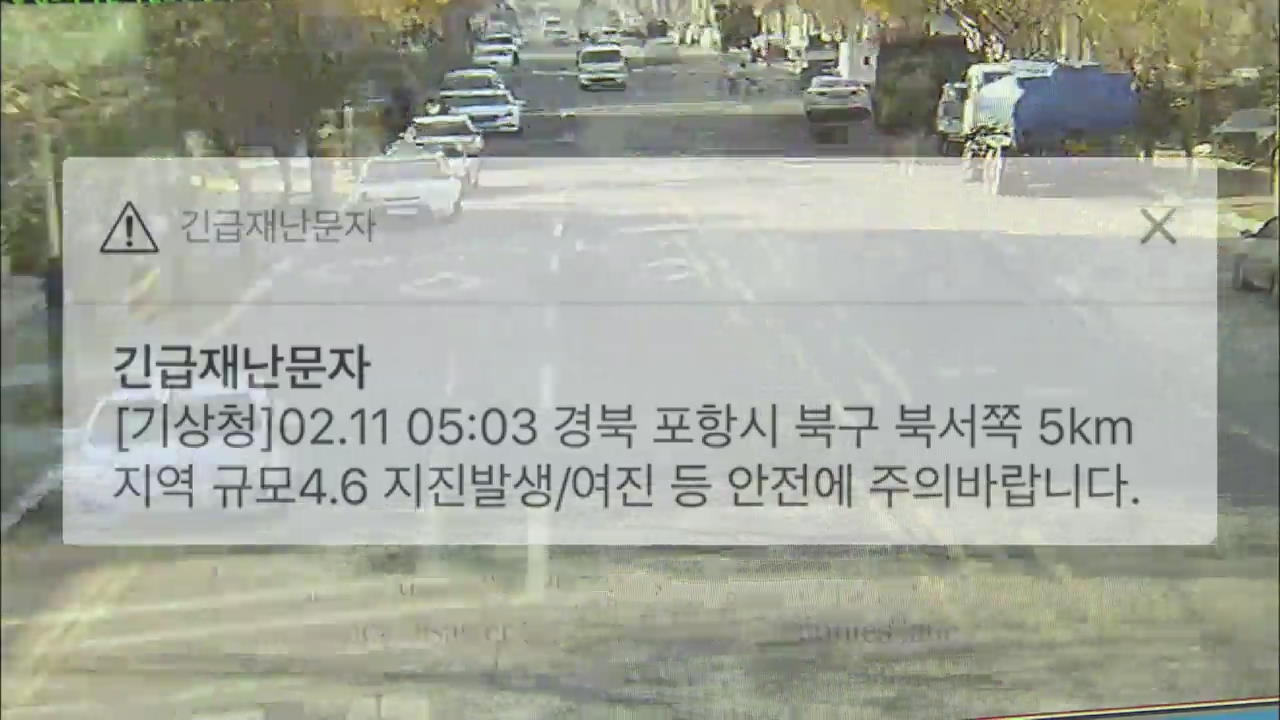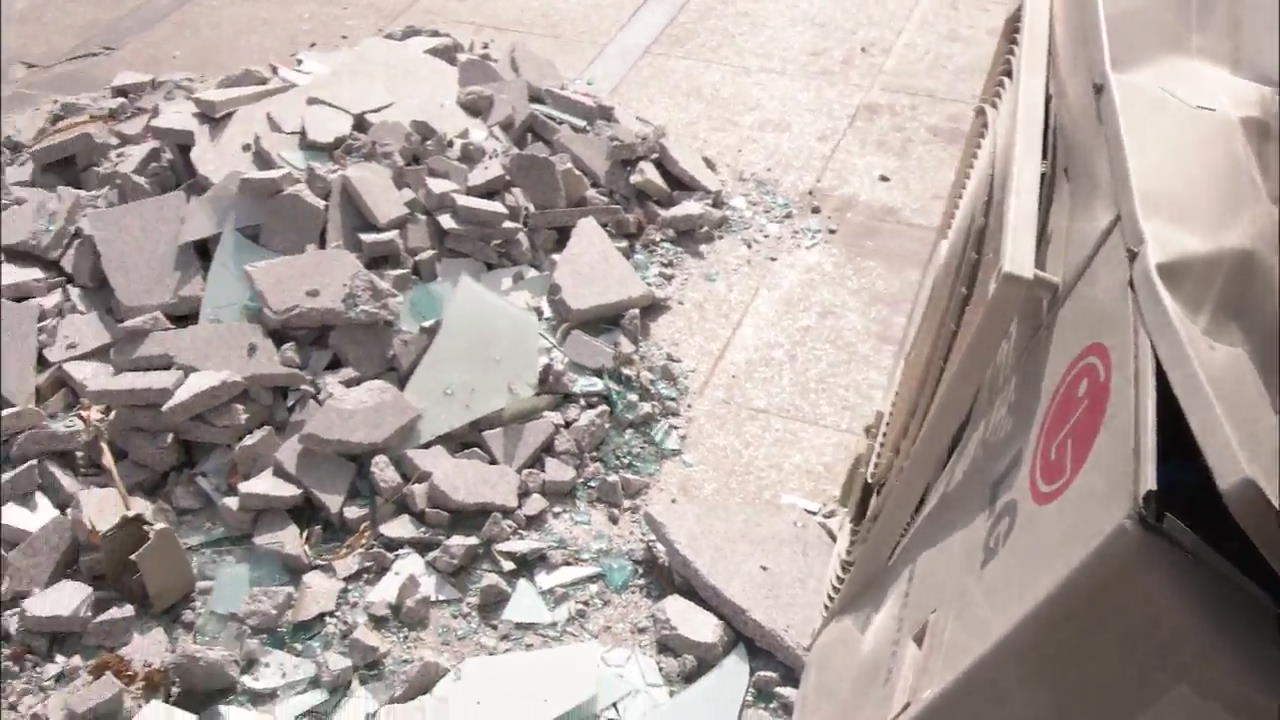Late Warning Message
입력 2018.02.12 (15:16)
수정 2018.02.12 (16:45)
읽어주기 기능은 크롬기반의
브라우저에서만 사용하실 수 있습니다.
[Anchor Lead]
Sunday’s tremor was registered at 5:03 a.m., but the emergency disaster text message arrived 7 minutes later at 5:10. In this case it appears that the Korea Meteorological Administration's early warning plan was not executed properly.
[Pkg]
A strong aftershock again rocked the Pohang area. Yesterday's aftershock was the strongest since a 5.4-magnitude earthquake hit the region three months ago in November. In the Gyeongsangbuk-do region close to the epicenter, an intensity 5 tremor was felt and the shaking was felt even in Gyeongsangnam-do Province farther south.
[Soundbite] Woo Nam-cheol(Korea Meteorological Administration) : "An intensity 5 means the tremor is strong enough to wake people up and throw down items from shelves and bookcases."
Roughly 90 aftershocks stronger than 2.0 magnitude took place so far. But, they've become more sporadic in the new year. However, yesterday's aftershock was the biggest one yet and a total surprise. 33 aftershocks occurred on the day of the main quake last year, and 67 were recorded over the next 15 days. Only one aftershock was registered in January, but the situation is growing more serious since yesterday's tremor.
[Soundbite] Prof. Hong Tae-kyung(Yonsei Univ.) : "Stress has been accumulating since the main earthquake. This 4.6-magnitude aftershock seems to have occurred as the accumulated stress erupted along the fault planes that didn't break the last time."
Amid the concerns that aftershocks as strong as yesterday's can occur anytime, people are blasting the government for sending out emergency disaster text messages seven minutes too late. Since prompt communication of disaster information is paramount, the emergency message transmission system must be maintained properly to prevent any more system errors.
Sunday’s tremor was registered at 5:03 a.m., but the emergency disaster text message arrived 7 minutes later at 5:10. In this case it appears that the Korea Meteorological Administration's early warning plan was not executed properly.
[Pkg]
A strong aftershock again rocked the Pohang area. Yesterday's aftershock was the strongest since a 5.4-magnitude earthquake hit the region three months ago in November. In the Gyeongsangbuk-do region close to the epicenter, an intensity 5 tremor was felt and the shaking was felt even in Gyeongsangnam-do Province farther south.
[Soundbite] Woo Nam-cheol(Korea Meteorological Administration) : "An intensity 5 means the tremor is strong enough to wake people up and throw down items from shelves and bookcases."
Roughly 90 aftershocks stronger than 2.0 magnitude took place so far. But, they've become more sporadic in the new year. However, yesterday's aftershock was the biggest one yet and a total surprise. 33 aftershocks occurred on the day of the main quake last year, and 67 were recorded over the next 15 days. Only one aftershock was registered in January, but the situation is growing more serious since yesterday's tremor.
[Soundbite] Prof. Hong Tae-kyung(Yonsei Univ.) : "Stress has been accumulating since the main earthquake. This 4.6-magnitude aftershock seems to have occurred as the accumulated stress erupted along the fault planes that didn't break the last time."
Amid the concerns that aftershocks as strong as yesterday's can occur anytime, people are blasting the government for sending out emergency disaster text messages seven minutes too late. Since prompt communication of disaster information is paramount, the emergency message transmission system must be maintained properly to prevent any more system errors.
■ 제보하기
▷ 카카오톡 : 'KBS제보' 검색, 채널 추가
▷ 전화 : 02-781-1234, 4444
▷ 이메일 : kbs1234@kbs.co.kr
▷ 유튜브, 네이버, 카카오에서도 KBS뉴스를 구독해주세요!
- Late Warning Message
-
- 입력 2018-02-12 15:10:57
- 수정2018-02-12 16:45:05

[Anchor Lead]
Sunday’s tremor was registered at 5:03 a.m., but the emergency disaster text message arrived 7 minutes later at 5:10. In this case it appears that the Korea Meteorological Administration's early warning plan was not executed properly.
[Pkg]
A strong aftershock again rocked the Pohang area. Yesterday's aftershock was the strongest since a 5.4-magnitude earthquake hit the region three months ago in November. In the Gyeongsangbuk-do region close to the epicenter, an intensity 5 tremor was felt and the shaking was felt even in Gyeongsangnam-do Province farther south.
[Soundbite] Woo Nam-cheol(Korea Meteorological Administration) : "An intensity 5 means the tremor is strong enough to wake people up and throw down items from shelves and bookcases."
Roughly 90 aftershocks stronger than 2.0 magnitude took place so far. But, they've become more sporadic in the new year. However, yesterday's aftershock was the biggest one yet and a total surprise. 33 aftershocks occurred on the day of the main quake last year, and 67 were recorded over the next 15 days. Only one aftershock was registered in January, but the situation is growing more serious since yesterday's tremor.
[Soundbite] Prof. Hong Tae-kyung(Yonsei Univ.) : "Stress has been accumulating since the main earthquake. This 4.6-magnitude aftershock seems to have occurred as the accumulated stress erupted along the fault planes that didn't break the last time."
Amid the concerns that aftershocks as strong as yesterday's can occur anytime, people are blasting the government for sending out emergency disaster text messages seven minutes too late. Since prompt communication of disaster information is paramount, the emergency message transmission system must be maintained properly to prevent any more system errors.
Sunday’s tremor was registered at 5:03 a.m., but the emergency disaster text message arrived 7 minutes later at 5:10. In this case it appears that the Korea Meteorological Administration's early warning plan was not executed properly.
[Pkg]
A strong aftershock again rocked the Pohang area. Yesterday's aftershock was the strongest since a 5.4-magnitude earthquake hit the region three months ago in November. In the Gyeongsangbuk-do region close to the epicenter, an intensity 5 tremor was felt and the shaking was felt even in Gyeongsangnam-do Province farther south.
[Soundbite] Woo Nam-cheol(Korea Meteorological Administration) : "An intensity 5 means the tremor is strong enough to wake people up and throw down items from shelves and bookcases."
Roughly 90 aftershocks stronger than 2.0 magnitude took place so far. But, they've become more sporadic in the new year. However, yesterday's aftershock was the biggest one yet and a total surprise. 33 aftershocks occurred on the day of the main quake last year, and 67 were recorded over the next 15 days. Only one aftershock was registered in January, but the situation is growing more serious since yesterday's tremor.
[Soundbite] Prof. Hong Tae-kyung(Yonsei Univ.) : "Stress has been accumulating since the main earthquake. This 4.6-magnitude aftershock seems to have occurred as the accumulated stress erupted along the fault planes that didn't break the last time."
Amid the concerns that aftershocks as strong as yesterday's can occur anytime, people are blasting the government for sending out emergency disaster text messages seven minutes too late. Since prompt communication of disaster information is paramount, the emergency message transmission system must be maintained properly to prevent any more system errors.
이 기사가 좋으셨다면
-
좋아요
0
-
응원해요
0
-
후속 원해요
0

















이 기사에 대한 의견을 남겨주세요.